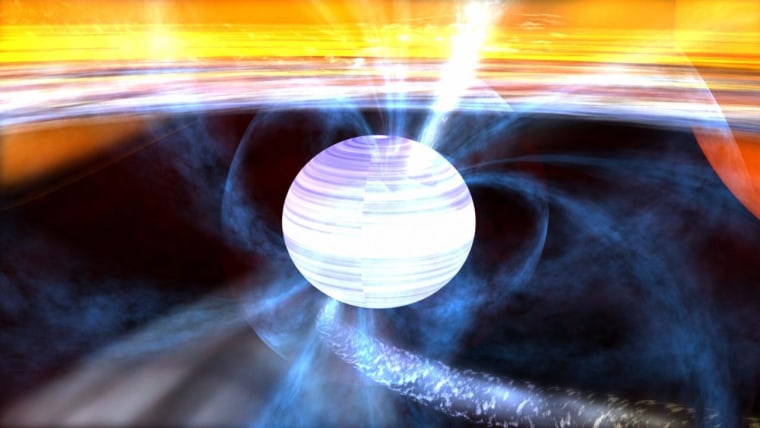Since their discovery 40 years ago, pulsars — the rapidly spinning, highly magnetized crushed cores of exploded stars — have largely been detected via the pulsing radio signals emitted by their lighthouse beam-like jets. But astronomers have suspected that these pulses give only the slightest hint of the true power of these cosmic dynamos.
With the launch of NASA's Fermi Gamma-ray Space Telescope (formerly GLAST) in June of last year, scientists are finally getting a glimpse of the powerful hearts of these stellar beasts. In its first four months of operation, Fermi detected more than three dozen pulsars, 12 of which are new gamma-ray-only pulsars.
"We know of 1,800 pulsars, but until Fermi we saw only little wisps of energy from all but a handful of them," said pulsar astronomer Roger Romani of Stanford University in California. "Now, for dozens of pulsars, we're seeing the actual power of these machines."
The astronomers now find that some pulsar bursts are generated far above the star's surface.
Romani and his colleagues presented the Fermi findings earlier this month at the annual meeting of the American Astronomical Society in Long Beach, Calif. Romani said that these were just the "first wave of such discoveries," and that they will usher in "a new era of high-energy pulsar physics."
Sweeping beams
Pulsars (short for "pulsating star") were first discovered in 1967 by Jocelyn Bell Burnell and Anthony Hewish. The astronomers were perplexed by the incredibly regular radio emissions they detected; they first thought they could be transmissions from extraterrestrial civilizations.
Astronomers later determined that pulsars were actually rapidly spinning neutron stars, the extremely dense and heavy crushed cores left behind when a massive star explodes.
The pulsing radio signals from the stars are thought to be caused by narrow, lighthouse-like beams emanating from the stars' magnetic poles. If a star's spin axis doesn't align exactly with its magnetic poles, these beams sweep across the sky. The pulses can repeat in anywhere from a few milliseconds to a few seconds.
If one of those beams happens to swing in Earth's direction, astronomers can detect the signal with radio telescopes. Unfortunately that makes any census of pulsars automatically biased because it can't count the pulsars that don't send their beams our way.
"That has colored our understanding of neutron stars for 40 years," Romani said.
And while radio beams are easy to detect, they account for only a tiny fraction (a few parts in a million) of a pulsar's total power. Gamma rays, on the other hand, account for 10 percent or more. That's where Fermi comes in.
"For the first time, Fermi is giving us an independent look at what heavy stars do," Romani said.
Gamma ray revisions
A pulsar's intense electric and magnetic fields and rapid spin accelerate particles to close to the speed of light. Gamma rays let astronomers glimpse the particle accelerator's heart.
Fermi's observations of gamma rays in new and previously known pulsars is forcing astronomers to revise their picture of how these particle accelerators work and how the gamma rays are emitted.
"We used to think the gamma rays emerged near the neutron star's surface from the polar cap, where the radio beams form," said astrophysicist Alice Harding of NASA's Goddard Space Flight Center in Greenbelt, Md. She helped present the findings. "The new gamma-ray-only pulsars put that idea to rest."
The picture that is now emerging is one of pulsed gamma rays arising far above the neutron star. For the Vela pulsar, the brightest persistent gamma-ray source in the sky, the emission region is thought to lie about 300 miles from the star, which itself has a diameter of just 20 miles.
Particles produce the gamma rays as they accelerate along arcs of the pulsar's open magnetic field. This model means that gamma rays would be beamed broadly across the sky, not in the narrow beam like the radio signals.
This finding "puts the nail in the coffin of the classic polar cap model," Romani said.
There is still some debate as to whether gamma ray emission starts at high altitudes over the star or from the star's surface and emanates all the way out.
"So far, Fermi observations to date cannot distinguish which of these models is correct," Harding said.
Millisecond pulsars
Fermi also picked up pulsed gamma rays from seven "millisecond pulsars," so called because they spin between 100 and 1,000 times a second.
These rapid rotators, even by pulsar standards, move at up to one tenth of the speed of light.
Far older than "normal" pulsars such as the Vela pulsar, these speed demons seem to break the rules because pulsars tend to slow in their rotation as they age (the 10,000-year-old CTA 1 pulsar, which the Fermi team announced in October, slows by about a second every 87,000 years).
Millisecond pulsars seem to get a second lease on life because they reside in binary star systems. As their companion star ages and expands, it does so to the point where the pulsar can start to siphon off material, forming an accretion disk. The accretion disk has force that speeds up the pulsar, allowing it to rotate "at this furious rate for about a billion years tomorrow," Harding said.
These discoveries are likely just the beginning of what Fermi will find in terms of nearby pulsars, Harding said. "We probably will be discovering a lot more."
